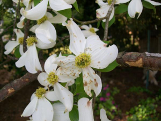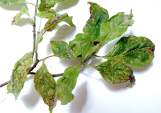Spot Anthracnose on Dogwood
go.ncsu.edu/readext?785755
en Español / em Português
El inglés es el idioma de control de esta página. En la medida en que haya algún conflicto entre la traducción al inglés y la traducción, el inglés prevalece.
Al hacer clic en el enlace de traducción se activa un servicio de traducción gratuito para convertir la página al español. Al igual que con cualquier traducción por Internet, la conversión no es sensible al contexto y puede que no traduzca el texto en su significado original. NC State Extension no garantiza la exactitud del texto traducido. Por favor, tenga en cuenta que algunas aplicaciones y/o servicios pueden no funcionar como se espera cuando se traducen.
Português
Inglês é o idioma de controle desta página. Na medida que haja algum conflito entre o texto original em Inglês e a tradução, o Inglês prevalece.
Ao clicar no link de tradução, um serviço gratuito de tradução será ativado para converter a página para o Português. Como em qualquer tradução pela internet, a conversão não é sensivel ao contexto e pode não ocorrer a tradução para o significado orginal. O serviço de Extensão da Carolina do Norte (NC State Extension) não garante a exatidão do texto traduzido. Por favor, observe que algumas funções ou serviços podem não funcionar como esperado após a tradução.
English
English is the controlling language of this page. To the extent there is any conflict between the English text and the translation, English controls.
Clicking on the translation link activates a free translation service to convert the page to Spanish. As with any Internet translation, the conversion is not context-sensitive and may not translate the text to its original meaning. NC State Extension does not guarantee the accuracy of the translated text. Please note that some applications and/or services may not function as expected when translated.
Collapse ▲Dogwood tree buds are beginning to swell. These trees are a favorite herald of spring. The bracts come out before the leaves and are the real eye-catchers – white, pale pink, or sometimes reddish-pink, with small clusters of the true yellow flowers centered in the middle.
The Cornus florida or Flowering Dogwood is typically modest in size. Usually 15-25 feet tall and 4-6 inches in diameter it can sometimes grow to 40 ft tall and growth to a foot or more wide. The “flower” is recognized as the NC state flower and is a lower-canopy woodland tree found throughout our state. Historically, Cornus florida was used to produce ink and scarlet dye and the hard, dense wood was valued for mallets and tool handles. Tannins found in parts of the tree were harvested for medicinal uses.
While it prefers organically rich, moist, acidic, well-draining soils in part shade it can be grown in average soil in sun as long as the roots are kept protected, cool and moist since their shallow root systems make them susceptible to leaf scorch during long droughts. Unfortunately, drought is not the only concern for these beauties. They are preyed upon by a number of insect pests as well as deer, they don’t handle pollution problems and are susceptible to fungal pathogens as well. Spot anthracnose (Elsinoe corni) is a common problem and control of this disease is hard to achieve.

1 Spot anthracnose on dogwood (Cornus sp) PDIC

2 Leaf spot anthracnose on Dogwood by Steve Pettis, Jr
What to look for? Cool, wet weather. Check. In the coming months, scout for tiny spots with reddish, purplish borders and tan centers on the bracts and leaves of dogwood trees. The disease is most severe when we have high rainfall amounts as the flower buds are opening and as the leaf buds are opening. The fungus also survives in the shoots and on the fruit. In the spring when we get more rainfall we get the disease symptoms. But no rainfall means very little of this disease and you can manage moisture levels at the shallow root levels with irrigation and mulch. With high rainfall amounts look for problems and if you had it last year, keep scouting for it this year as it survives in the shoots. Rake up fallen leaves and debris regardless as a precaution to remove sporulation sites and other pest hideaways. Fungicide spraying every 7-14 days from flower bud break to complete leaf expansion is a management technique, but If you have more than one or 2 specimen trees to get all the extra attention – it’s not very practical.
A sound practice in any garden is to choose plants with disease resistance in the first place. In the ornamental nursery industry many varieties have been hybridized for this characteristic as well as other desirable traits. From ‘Cherokee Sunset’ to ‘Weaver’s White’ there are many choices available.
Despite the potential for spot anthracnose, the flowering dogwood is a lovely addition to a shade garden. From the heraldic bright colors of spring, to cool green summer shade, flaming oranges, and red autumn leaf colors, and distinctive geometric bark in winter, there is always something to enjoy. To view a list of cultivars and varieties that are disease resistant, as well as other good-to-know information about this plant, take a look at Cornus Florida.
Minda Daughtry is the Horticulture Agent for North Carolina Cooperative Extension in Lee County.




